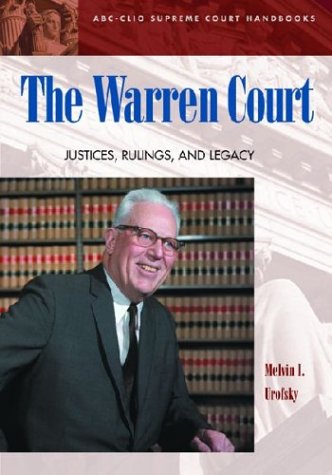

Most ebook files are in PDF format, so you can easily read them using various software such as Foxit Reader or directly on the Google Chrome browser.
Some ebook files are released by publishers in other formats such as .awz, .mobi, .epub, .fb2, etc. You may need to install specific software to read these formats on mobile/PC, such as Calibre.
Please read the tutorial at this link. https://ebooknice.com/page/post?id=faq
We offer FREE conversion to the popular formats you request; however, this may take some time. Therefore, right after payment, please email us, and we will try to provide the service as quickly as possible.
For some exceptional file formats or broken links (if any), please refrain from opening any disputes. Instead, email us first, and we will try to assist within a maximum of 6 hours.
EbookNice Team

Status:
Available5.0
14 reviews
ISBN 10: 157607160X
ISBN 13: 9781576071601
Author: Melvin Urofsky
A survey and analysis of the historical context, key figures, and lasting legacy of the Warren Court. Earl Warren served as chief justice of the U.S. Supreme Court from 1953 until the end of the tumultuous 1960s. This book shows why conservative critics still view this court as out of control and leftist, while its liberal fans still cheer what they view as the court's progressive activism. Among this court's contributions to American life are the rights accorded to the accused in Miranda v. Arizona, the limits it placed on school prayer, and the abolition of school segregation in Brown v. Board of Education. To understand such basic American principles as equal protection, freedom of speech, freedom of the press, freedom of religion, separation of church and state, the rights of the accused, and the right to privacy, every citizen should understand the Warren Court.
PART ONE Justices, Rulings, and Legacy
1 The Warren Court and the Period
The Roosevelt Era
World War II
The Post–World War Era
The Black-Frankfurter Debate
Conclusion
2 The Justices
The Superchief and His Associates
Earl Warren
Hugo Lafayette Black
Stanley Forman Reed
Felix Frankfurter
William Orville Douglas
Robert Houghwout Jackson
Harold Hitz Burton
Tom Campbell Clark
Sherman Minton
John Marshall Harlan
William Joseph Brennan, Jr.
Charles Evans Whittaker
Potter Stewart
Byron Raymond White
Arthur Joseph Goldberg
Abe Fortas
Thurgood Marshall
Conclusion
3 The Decisions
The Equal Protection of the Law
The Road to Brown
Brown v. Board of Education (1954)
Bolling v. Sharpe (1954)
The Failure of Brown II
Little Rock and Cooper v. Aaron (1958)
The Court Picks Up the Tempo
Expanding the Meaning of Equal Protection
Demonstrations, Sit-Ins, and Public Accommodation Cases
Voting Rights
Poverty as a Suspect Classification
The Reapportionment Cases
“People, not land or trees or pastures, vote.”
Reapportionment and Democracy
The First Amendment: The Speech Clause
Free Speech and Society
The Red Scare
Burying Seditious Libel
Freedom of Association
Obscenity
The Growing Morass
The First Amendment: The Press Clause
New York Times v. Sullivan (1964)
Refining the Times Test
The First Amendment: The Religion Clauses
The Establishment Clause before Warren
School Prayer—The Engel Case
Bible-reading in the Schools
Evolution and Creation
Aid to Parochial Schools
The Free Exercise Clause
Sunday Closing Laws
Saturday Work
Conscientious Objectors
The Rights of the Accused
Criminal Procedure and Incorporation
The Fourth Amendment: Search Warrants
The Fourth Amendment and Wiretapping
The Exclusionary Rule
The Sixth Amendment and the Right to Counsel
The Fifth Amendment and the Great Privilege
The Right to Privacy
A Final Lesson in Democracy
4 The Legacy
The Transformation of the Court
The Burger Court and Equal Protection
The Rehnquist Court and Equal Protection
Affirmative Action
Gender Discrimination
The Legacy of Warren Court Equal Protection
The Burger Court and Speech
The Burger Court and a Free Press
The Rehnquist Court and Free Speech
Flag Burning
The Burger Court and the Religion Clauses
The Rehnquist Court and the Religion Clauses
The Burger Court and Rights of the Accused
The Rehnquist Court and Rights of the Accused
The Right to Privacy—Abortion and the Right to Die
Conclusion: The Warren Court’s Legacy
PART TWO Reference Materials
Key People, Laws, and Events
Accommodationist
Agricultural Adjustment Acts of 1933 and 1938 (AAA)
Blackmun, Harry Andrew (1908–1999)
Brandeis, Louis Dembitz (1856–1941)
Breyer, Stephen G. (1938–)
Burger, Warren Earl (1907–1995)
Cardozo, Benjamin Nathan (1870–1938)
Civil Rights Act of 1964
Clear and Present Danger Test
Common Law
Congress of Racial Equality (CORE)
Eisenhower, Dwight David (1890–1969)
Fair Employment Practices Commission
Ginsburg, Ruth Joan Bader (1933– )
Holmes, Oliver Wendell, Jr. (1841–1935)
House Committee on Un-American Activities (HUAC)
Incorporation
Internal Security (McCarron) Act of 1950
Judicial Activism
Judicial Restraint
Kennedy, Anthony McLeod (1936– )
Legal Realism
Living Constitution
Marbury v. Madison (1803)
McCarthyism
National Association for the Advancement of Colored People (NAACP)
New Deal
Nixon, Richard Milhous (1913–1994)
O’Connor, Sandra Day (1930– )
Original Intent
Powell, Lewis Franklin, Jr. (1907–1998)
Rehnquist, William Hubbs (1924– )
Roosevelt, Franklin Delano (1882–1945)
Scalia, Antonin (1936– )
Smith Act (Alien Registration Act) of 1940
Souter, David Hackett (1939– )
State Action
Stevens, John Paul (1920– )
Stone, Harlan Fiske (1872–1946)
Thomas, Clarence (1948– )
Truman, Harry S. (1884–1972)
Vinson, Frederick Moore (1890–1953)
Voting Rights Act of 1965
Chronology
Glossary
Selected Bibliography
Internet Sources
Emory University School of Law (2 sites)
Federal Judicial Center
Federal Judiciary Homepage
Federal Legal Information Through Electronics (FLITE)
Findlaw
Jurist: The Legal Education Network
Legal Information Institute (LII)
Lexis-Nexis Academic Universe
National Center for State Courts
Oyez Project
Supreme Court
Westlaw
Yahoo Law
Tags: Melvin Urofsky, Warren, Court